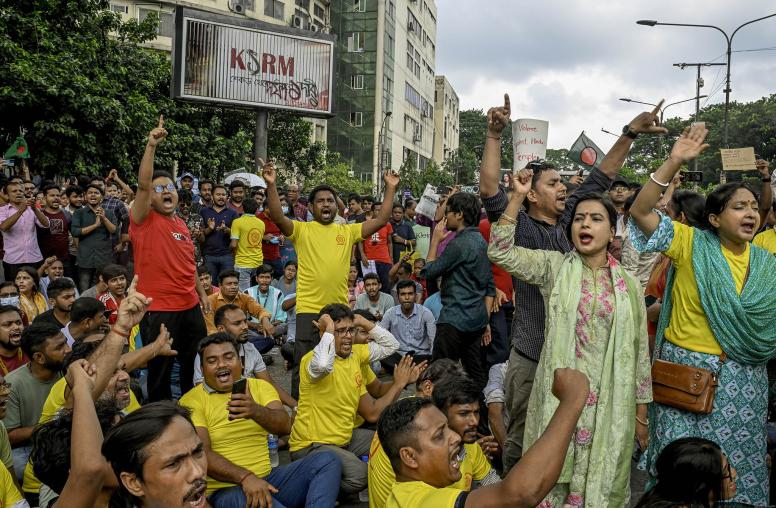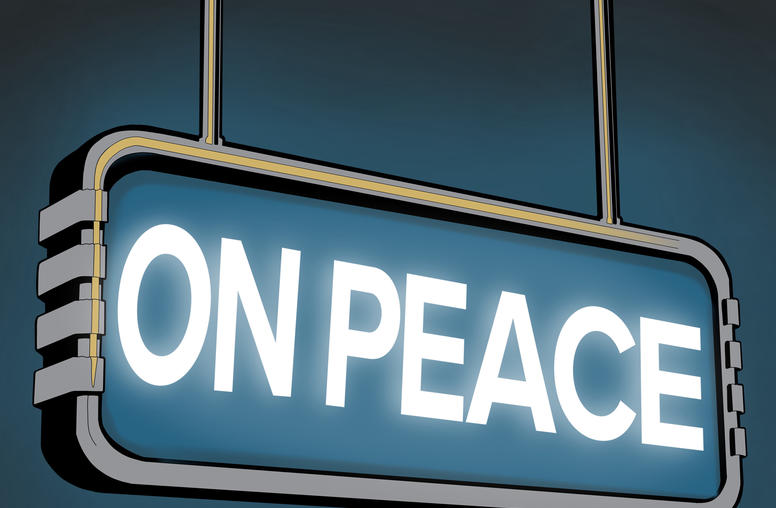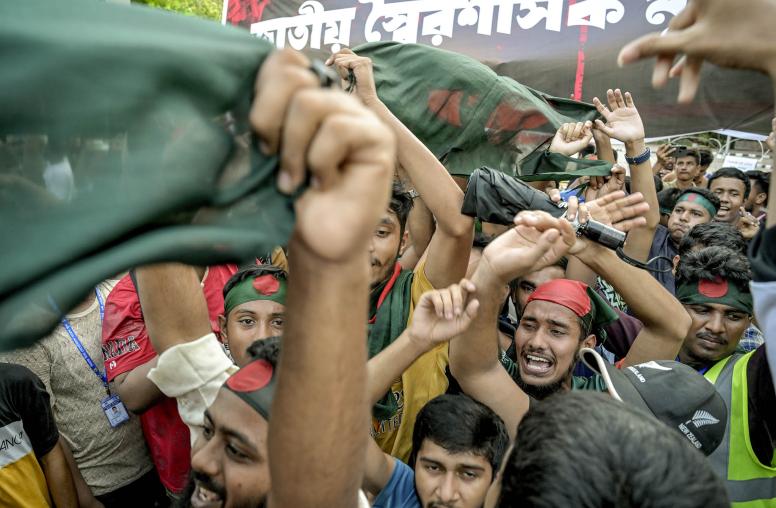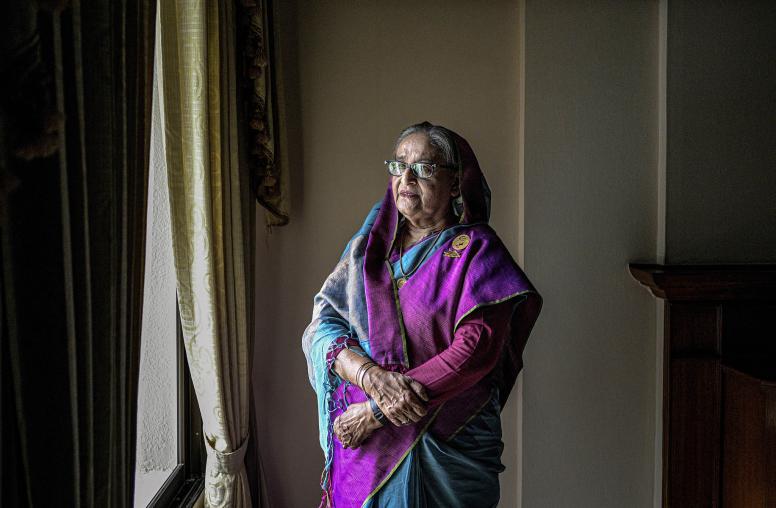Coronavirus Tightens its Grip on South Asia
As COVID-19 infections rise, governments struggle with the challenge of saving lives and livelihoods.
In South Asia, home to some of the world’s most densely populated nations, the COVID-19 pandemic has tightened its grip—causing infections to soar, battering economies, and plunging many into poverty. Governments have mostly struggled to cope.

Governments Struggle to Contain the Virus
India’s response has been “mixed,” according to Arun Singh, a former ambassador of India to the United States. With more than 350,000 cases and just shy of 12,000 deaths as of June 17, India is the fourth worst-hit nation in the world behind the United States, Brazil, and Russia, according to Johns Hopkins University’s Coronavirus Resource Center. Major metropolises—Delhi and Mumbai—have become coronavirus hot spots. Infections in Delhi alone could rise to more than half a million by July. This is bad news for hospitals that are packed to capacity.
Indian Prime Minister Narendra Modi’s government acted well before the World Health Organization (WHO) declared COVID-19 a pandemic. In January, the government placed restrictions on passengers travelling from China, where the first cases of the coronavirus were reported. “Unfortunately, [the government] didn’t pay the same attention to the passengers coming in from Europe or to those coming in from the Gulf” from where the first cases of COVID-19 arrived in India, said Singh.
However, Singh said because the government had been quick to impose a lockdown and restrictions on international travel, India was able to slow the rate of increase in infections. The government bought itself time to build capacity and create public awareness about the measures needed to stop transmission of the virus, he said. Singh spoke in an online discussion hosted by the U.S. Institute of Peace on June 17. While there has been a recent spike in cases, especially in urban areas, the number of deaths as a percentage of the population are still relatively low.
In Pakistan, Prime Minister Imran Khan was initially reluctant to lock down the country because of the damage it would do to the livelihoods of millions of Pakistanis. He eventually agreed to a lockdown; this was subsequently lifted on May 9.
As of June 17, Pakistan had more than 154,000 cases of COVID-19 and almost 3,000 deaths, according to Johns Hopkins University. Health experts and organizations, including the World Health Organization, have criticized the government’s decision to end the lockdown. In Sindh, one of Pakistan’s four provinces, the opposition-led provincial government has maintained its lockdown.
“Like other countries … Pakistan had no primer to guide it about what to do when the first infection was confirmed,” on February 26, said Maleeha Lodhi, a former ambassador of Pakistan to the United States. Khan, like other world leaders, “had to make tough choices and strike a balance … between addressing the health crisis and its economic fallout, especially on the poor and vulnerable,” said Lodhi.
In Bangladesh, the government was slow to respond. “Initially, we were complacent,” said Tariq Karim, a former ambassador of Bangladesh to the United States. Eventually, the government declared an “extended public holiday” instead of a lockdown. People traveled to the beach, and while social distancing was advocated it was “violated more than practiced,” said Karim.
In Sri Lanka, in comparison, the number of infections (1,924) and deaths (11) is relatively low. “In that respect, we seem to be doing relatively well compared to our neighbors,” said Paikiasothy Saravanamuttu, executive director of the Centre for Policy Alternatives in Sri Lanka.
Wanted: More Testing
Initially, the number of cases relative to the huge populations of South Asian countries was quite low, giving people a false sense of security. But after lockdowns ended there has been a surge in cases. Even though the current numbers of COVID-19 infections in India, Pakistan, Bangladesh, and to a lesser extent, Sri Lanka, are alarming, inadequate testing likely masks more dire statistics.
Bangladesh has more than 98,000 cases and more than 1,300 deaths. “Our testing is one of the lowest in the world,” said Karim. He expects numbers to jump “exponentially” once testing increases. The same is true for India, Pakistan, and Sri Lanka.
The Pandemic’s Economic Impact
The pandemic has had an outsized impact in South Asia, where a significant number of people are engaged in the informal economy.
Tamanna Salikuddin, director of South Asia programs at USIP, who moderated the discussion, noted that the World Bank estimates that millions of people in South Asia will be pushed into extreme poverty as a result of the pandemic. A United Nations University-sponsored study by King’s College London and the Australian National University found that more than a billion people worldwide would be pushed into poverty; more than half will be in South Asia.
Bangladesh’s garment industry, which accounts for as much as 80 percent of the country’s exports and employs millions, has been ravaged as export orders evaporated overnight. Many workers are out of a job. Similarly, remittances from expatriate workers, particularly those in the Middle East, have gone down.
In Sri Lanka, the tourism industry, a key source of income, was in bad shape even before the pandemic struck after a deadly series of terrorist attacks on churches and hotels on Easter Sunday in 2019 left more than 250 people dead. The attacks, claimed by the Islamic State, caused tourists to avoid the island nation. “Tourism was very much on the back foot then, and now it has really been laid low,” said Saravanamuttu. Just as in Bangladesh, the apparel industry in Sri Lanka has also been adversely affected.
Desperate to limit the economic damage, governments have gradually begun to reopen their economies. This has come at a price, as the number of infections has started to climb.
Societal Challenges: ‘A Developing Country Challenge’
Governments are grappling with the lives-versus-livelihoods conundrum as whole sections of society are plunged into poverty as a result of the lockdown. In Bangladesh, Prime Minister Sheikh Hasina has been “doing a delicate tightrope walk trying to balance the requirements of saving lives as well as livelihoods,” said Karim.
The same is true for Prime Minister Khan in Pakistan. Lodhi, however, emphasized the need to prioritize human security. “Trying to make a choice between lives and livelihoods is actually a false choice. Unless you save lives, you can’t save livelihoods,” she said.
Lodhi said most people are not taking the coronavirus threat seriously. They are lax about social distancing—a practice recommended by health experts to break the transmission of COVID-19. Acknowledging that social distancing is more challenging in populations that live in cramped conditions and have limited access to health and sanitation services, she said: “The poor cannot practice social distancing … This is a developing country challenge.”
In Sri Lanka, the armed forces have led the response to the pandemic. The reason for this is that Sri Lanka’s president, Gotabaya Rajapaksa, is a former defense secretary and army man who leans heavily on the armed forces, explained Saravanamuttu.
Saravanamuttu said the pandemic has provided the Rajapaksa government an excuse to function in an authoritarian manner. “What we are having is a militarization of governance under the cover of the COVID virus [response],” he said.
The Pandemic’s Social Impact: ‘Currents of Resentment’
All over the world, the pandemic has exacerbated societies’ fault lines and heightened the prospects of unrest. The same is true for South Asia.
In India, migrant workers desperate to return to their villages from the cities where they had moved to eke out a living were left stranded by the lockdown. The “most visible and consequential” impact of the pandemic has been on the daily wage migrant worker, admitted Singh.
In Bangladesh, people who until recently had jobs at which they earned a decent living are now forced to beg on the street. The “new poor are mostly the urban poor,” said Karim. “They were used to a better standard of life … Suddenly they do not have enough money to feed their family.”
High levels of unemployment have created “currents of resentment” among Bangladesh’s population, Karim said, adding: “We have, in a sense, elements of a perfect storm gathering.”



